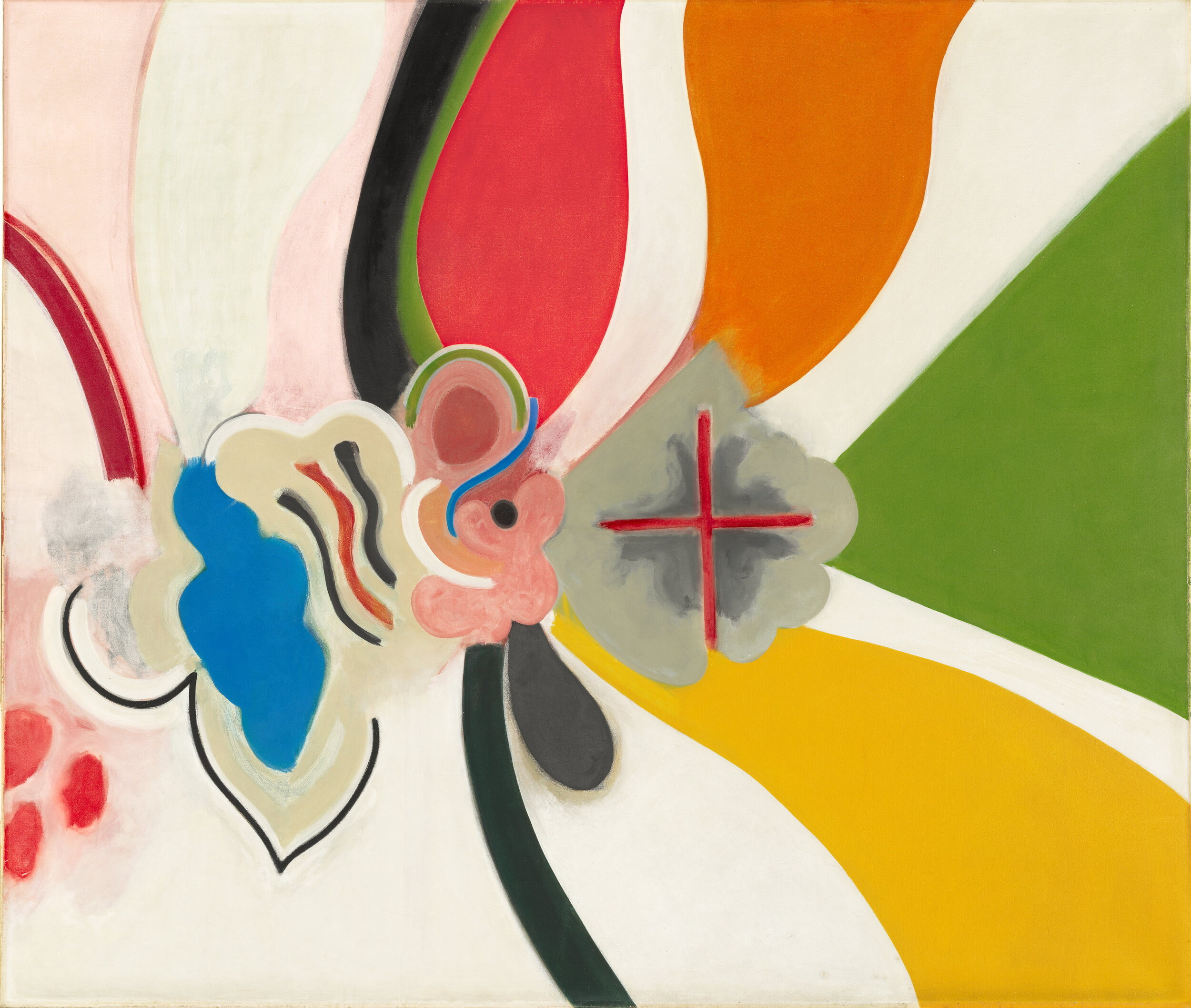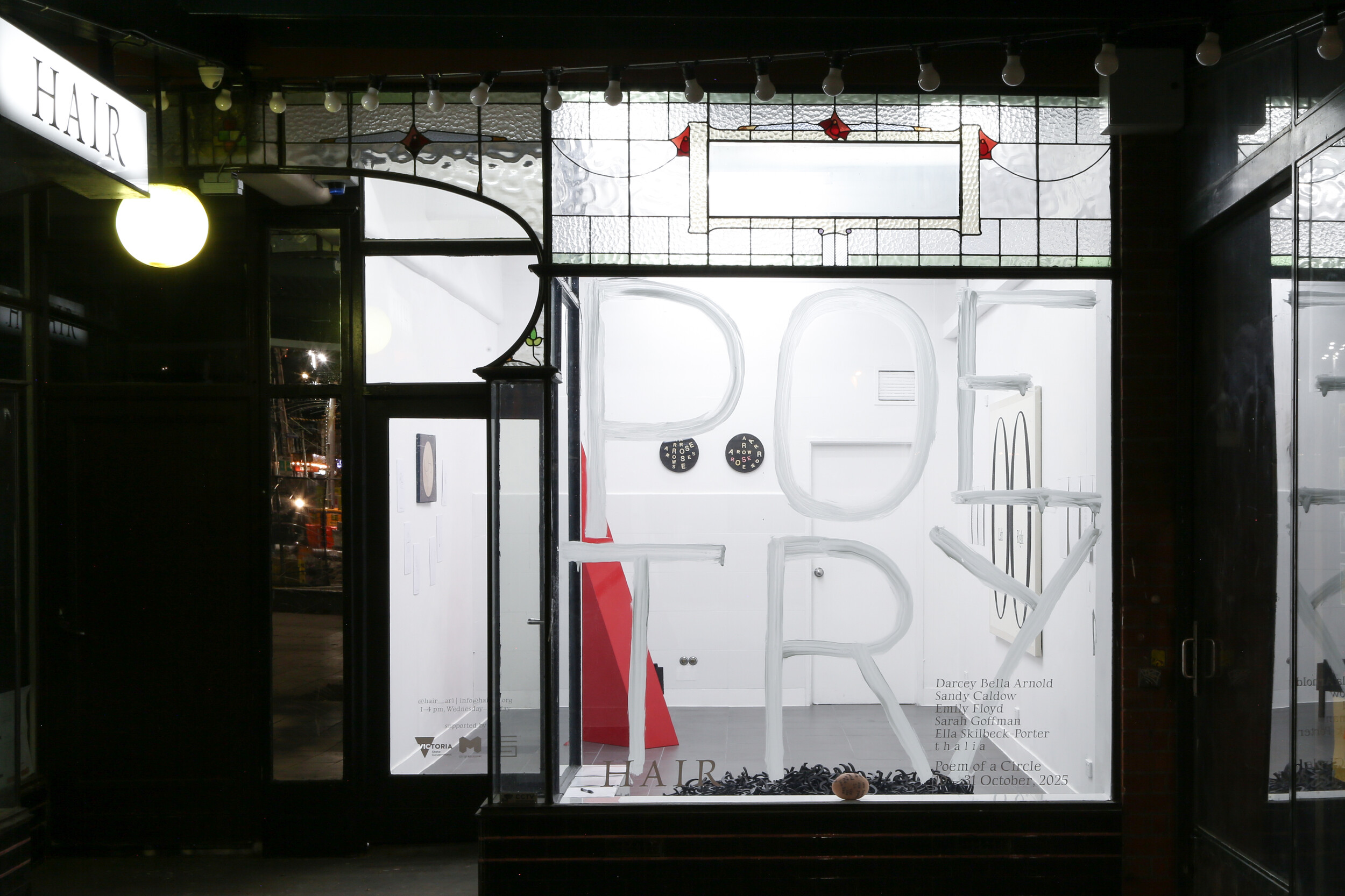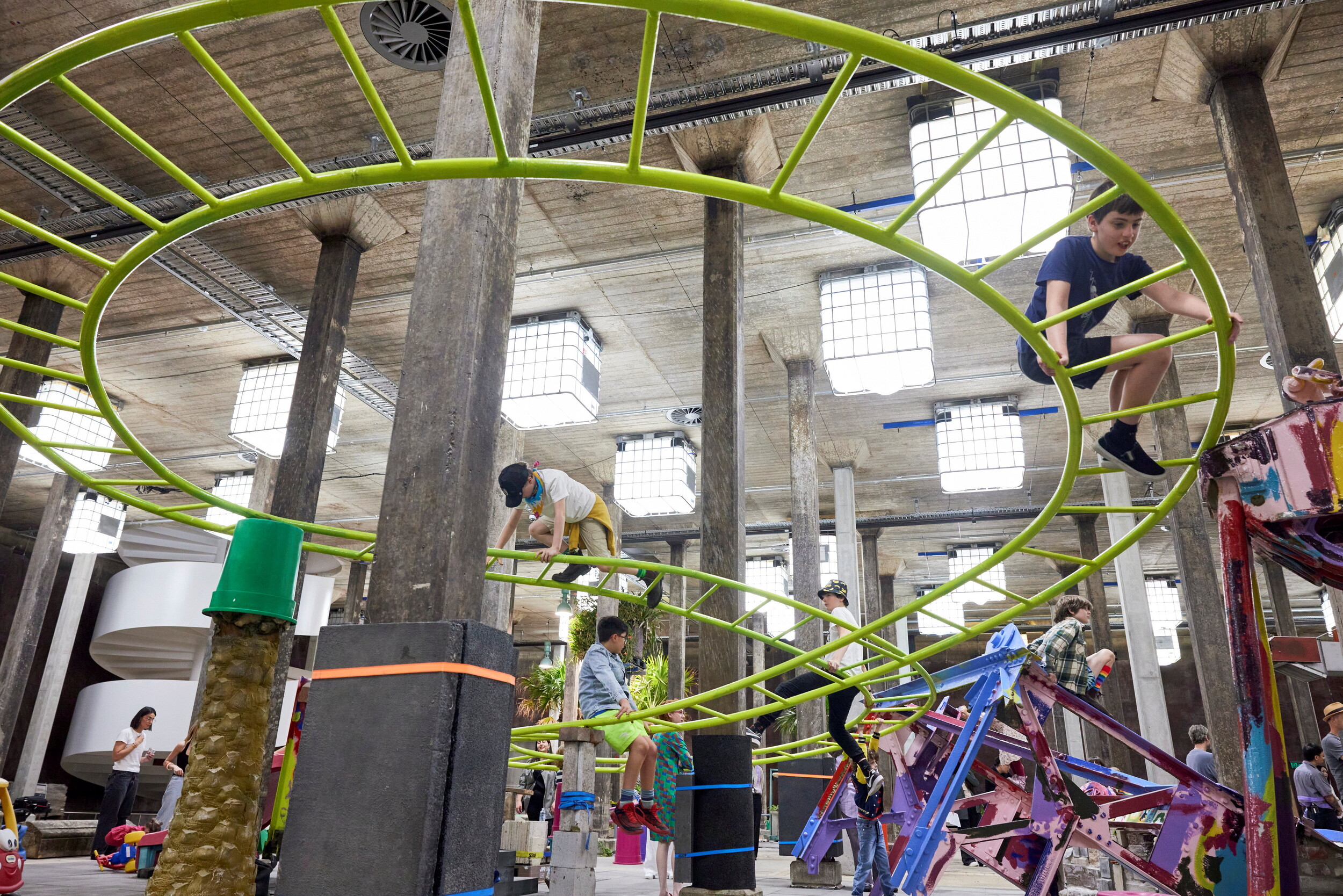Installation view of Lionel Fogarty, Burraloupoo, 2025. Darren Knight Gallery. Photo: Simon Hewson
Burraluopoo
Callum Gallagher
Lionel Fogarty, a Murri man with traditional connections to the Yugambeh and Kudjela peoples of modern-day Queensland, is known for his work as an activist and as one of Australia’s most accomplished poets (14 poetry collections over the last 45 years attest to this). His show Burraloupoo at Darren Knight demonstrates the recent extension of his practice to visual art, having debuted his paintings at The Condensery gallery in Toogoolawah earlier this year. The title for that show, Moiyum wungumbil mugerra bullonga, is useful for understanding the idiosyncratic nature of Fogarty’s verse. Translating to “waterlily whistle thunder yours”, it exemplifies his associative use of English, which resists colonial expectations of syntax and grammar (think the prose of Alexis Wright in poetic form). While in Burraloupoo Fogarty has continued this switch in medium from page to canvas, it is text that remains his overriding concern. Indeed, Burraloupoo contains an almost overwhelming amount of text—pushing his practice right to the brink of illegibility, threatening the very same close reading his work has always invited.

Installation view of Lionel Fogarty, Burraloupoo, 2025. Darren Knight Gallery. Photo: Simon Hewson
The first, instinctual response is to try to read all these painted texts one by one. This is no small undertaking, with the exhibition featuring 30 large-scale works mostly on tarpaulin and 36 smaller works mostly on canvas, the majority of which visualise previously published poems. As always in Fogarty’s work, one finds plenty of intelligent and direct critiques of a wide range of contemporary political issues. In I’m Not Santa (2023) he indicts Christmas as a capitalist vacuum tearing a hole out from the bottom of mum and dad’s wallet. In Al Qaeda Means the Word of God (2025) his words lash Western Imperialism’s complicity in constructing terrorism in the Middle East. The majority of the painted poems in Burraloupoo elaborate Fogarty’s lifelong stand against Australia’s systemic racism and the ongoing impacts of colonisation.
As this exhibition makes clear, however, Fogarty’s transition to painting is not simply a late career strategy to inject new life into his writing practice. It is a return. From the start, Fogarty’s sense of the English language has involved an awareness of text’s visual power in the political realm, beyond the page. Born on the Cherbourg Aboriginal Reserve mission in south-east Queensland, Fogarty grew up speaking Yoogum and Bundjalung. It was only at the age of fifteen, when Fogarty moved to Brisbane, that he taught himself to read and write English. At this time, Fogarty was heavily involved in political organising and activism, working with the Aboriginal Legal Service, Black Resource Centre, Black Community School and Murrie Coo-ee, work that ultimately saw Fogarty imprisoned in a maximum-security jail on charges of conspiring against the state. Pamphlets, legal paperwork, placards, and protest banners shaped the basis of Fogarty’s English lexicon, providing both its visual and political dimensions.
Fogarty’s turn to painting reflects this story. He took to painting, in part, after the encouragement of artists Richard Bell and Gordon Hookey, members of the Indigenous artist collective proppaNOW. (Another recent Sydney show by Kamilaroi artist Warraba Weatherall, also a member of proppaNOW, revealed the vital cross-generational influences of these artists.) Both Bell and Hookey’s paintings borrow directly from the visual language of protest banners with their vibrant colours and provocative use of language to confront the imagined white viewer, as in Bell’s Pay the Rent (2009) and Hookey’s Reiteration in Perpetuity (2010).

Lionel Fogarty, 339 Next Year All These Deaths, 2023. Acrylic on tarpaulin, 185 x 244cm. Photo: Simon Hewson
In Burraloupoo there are clear signs of Bell and Hookey’s influence, as in 339 Next Year All These Deaths (2023). Directly referencing the 339 recommendations of the 1991 The Royal Commission into Aboriginal Deaths in Custody in its title, 339 acts as a poignant reminder of the persistently atrocious rates of incarceration and death amongst Indigenous Australians under state care. As a text-based artistic response to this issue Fogarty’s work immediately recalls the recent success of Archie Moore’s Kith and Kin (2024), winner of the Golden Lion at the 60th Venice Biennale. However, whilst Moore’s work adopted a research-based approach that spatialised data in order to create an expansive monument to Indigenous victims of the Australian carceral system, Fogarty’s work stages a more direct form of address. In its painted form, the poem becomes a protest banner. The anger that was so carefully sublimated in Moore’s solemn monument is unleashed as Fogarty injects his subjectivity into the work.
339 loudly asserts that “No justices serve without language is a lost justice serve only in language belong a black fella.” Language and the power to wield it is, Fogarty suggests here, the key to justice. It is the language of the law that secures our rights (and therefore supposedly our justice), and it is language as a form of communication that shapes our realities and relations. Fogarty grasped this concept firsthand through his early activist work collating Indigenous accounts of injustice in written English for legal cases. Yet he has simultaneously known the hollowness with which the words of the law may ring out. His brother Daniel Yock died in the back of a police car after being arrested in 1993, two years after the Royal Commission’s findings in 1991.
As a poem, 339 offers a critique of language as a double-edged sword: one that can both protect and dismantle Black life. But as a painting it offers something more. Fogarty takes advantage of the visual space afforded by the form of painting to generate new mappings of his text. Two large fields of yellow and red encircle separate stanzas on the lower left and right of the painting. These not only reference the colours of the Aboriginal flag, but more radically becomes containers that separate varying ways of being in language. The yellow field tells of “valleys mountain ranges” and that “Endless waters can’t lie.” The red stages a stream of questions “Am I here in attendance to my heart?,” “Am I me or you am us?” Each contains Yugambeh–Bundjalung language in their headings. The collective effect is to stage what writer Édouard Glissant would call a “creolisation” of language that ambiguates its subject of address—at once acknowledging Indigenous worldviews, non-indigenous audiences and the gaps that separate them—all whilst decentring the white reader.

Installation view of Lionel Fogarty, Burraloupoo, 2025. Darren Knight Gallery. Photo: Simon Hewson
The new possibilities for communication that this creolisation allows, with its emphasis on the process of language instead of its contents, emerges in Accept the Queen’s Lovers (2025). Here Fogarty links his politics of the depicted word to graffiti: “The great graffiti not their country but they have a society awards for the warp of surprise.” Traditionally seen as vandalism in the West, graffiti defaces and overwrites—ironically much like the overwriting of Aboriginal place names and languages by English colonisation, which Fogarty calls the “great graffiti” of “society awards.” However, seen in a reparative light, graffiti creates a palimpsest that allows for re-reading, even as it seemingly denies that same act. It is in this second sense that Fogarty’s creolisation of English might described as a form of graffitiing. Like graffiti that sublimates the legibility of language into aesthetic concerns through idiosyncratic stylisation, so too does Fogarty’s painting.

Lionel Fogarty, Accept the Queen’s Lovers, 2025. Acrylic on tarpaulin, 236 x 150.5cm. Photo: Simon Hewson
Fogarty’s formal shift from page to painting in Burraloupoo, in other words, allows him to exceed the strictures of language as a direct form of communication, and to embrace a new set of aesthetic possibilities. As Fogarty himself says, “I don’t want to be a book on a shelf that doesn’t move.” Without the structure of the page, Fogarty’s writing breaks free from concerns of punctuation and spacing. The result is the condensing of words into a single, non-linear mass where sentences slip into those beneath them and refuse cessation. In Accept the Queen’s Lovers for example, the dot is no longer a full stop but decorative as it interrupts, delays, and divides English. Similarly, the blue hollow forms of the letters a, e, p, q, r, o, d, b, and g all become containers for bright spots of crimson pigment. In the lower section the work clashes aqua and yellow. These high contrasts make linear reading difficult, instead coalescing the letters into an expansive dynamic pattern that one can only scan and re-scan.

Lionel Fogarty, Saints are Homeless, 2023. Acrylic on tarpaulin, 257.5 x 208cm. Photo: Simon Hewson
Returning to 339, Fogarty’s painting practice once again allows words to drift into new constellations of meaning. The line quoted above, for instance (“No justices serve without language is a lost / justice serve only in language belong a black fella”), can just as easily be read as “language is a lost black fella.” This points to an experience of homelessness within the rooted structures of colonisation, including the English language—one that Fogarty has known himself. In Saints are Homeless (2023), Fogarty interrogates this experience, antagonising the colonial notion of home and questioning its role in constructing the more mobile Indigenous way of living as one of homelessness. Fogarty’s critique of this binary as a justification for the segregation and removal of Aboriginal children from homes rings out clearly: “religions are using the unhoused people for forgotten bush realization.” Given a new painted form, however, Saints are Homeless enacts a new notion of homelessness in defiance of colonial structures by rejecting the fixed and immovable place of words “at home” on the page. Instead painting grants them a new mobility as sentences wander errantly, no longer travelling along straight lines. This is echoed materially in the tarpaulins that Fogarty has painted on. While I am told there is no conceptual reasoning for the choice (indeed Fogarty does not discriminate, also painting on canvas), even the practical reasons for the choice of material replace a paradigm of fixity with mobility. Accessible, easily rolled up and stored, and suitable for working on outdoors, these tarpaulins are a homeless medium functioning as both temporary structures for Fogarty’s words and displaced bodies.

Lionel Fogarty, Connoisseur 2023. Acrylic on tarpaulin, 239 x 151cm. Photo: Simon Hewson
Taken as a whole, Burraluopoo enacts a powerful destabilisation and repurposing of the English language, one that both continues his existing poetic practice, and pushes it into a new field of possibilities. Fogarty’s paintings put aside the formal structure of the page that poetry is all too often forced to conform to, denying a colonial mastering of English and instead forcing the viewer to read on his terms. His highly idiosyncratic creole escapes from the white-reader-as-editor that seeks to “correct” divergent uses of language. Instead it stages a grammatical spin on Glissant’s “right to opacity.” As Connoisseur (2023) states, “Our communications is to our Murris, … your intellectual and academic criticisms have been your industry out of our oppression.” Fogarty’s poetry is in a book where you can read it. Fogarty’s paintings show why this is not enough.
Callum Gallagher is an art historian, writer, and arts worker based on Gadigal land.


